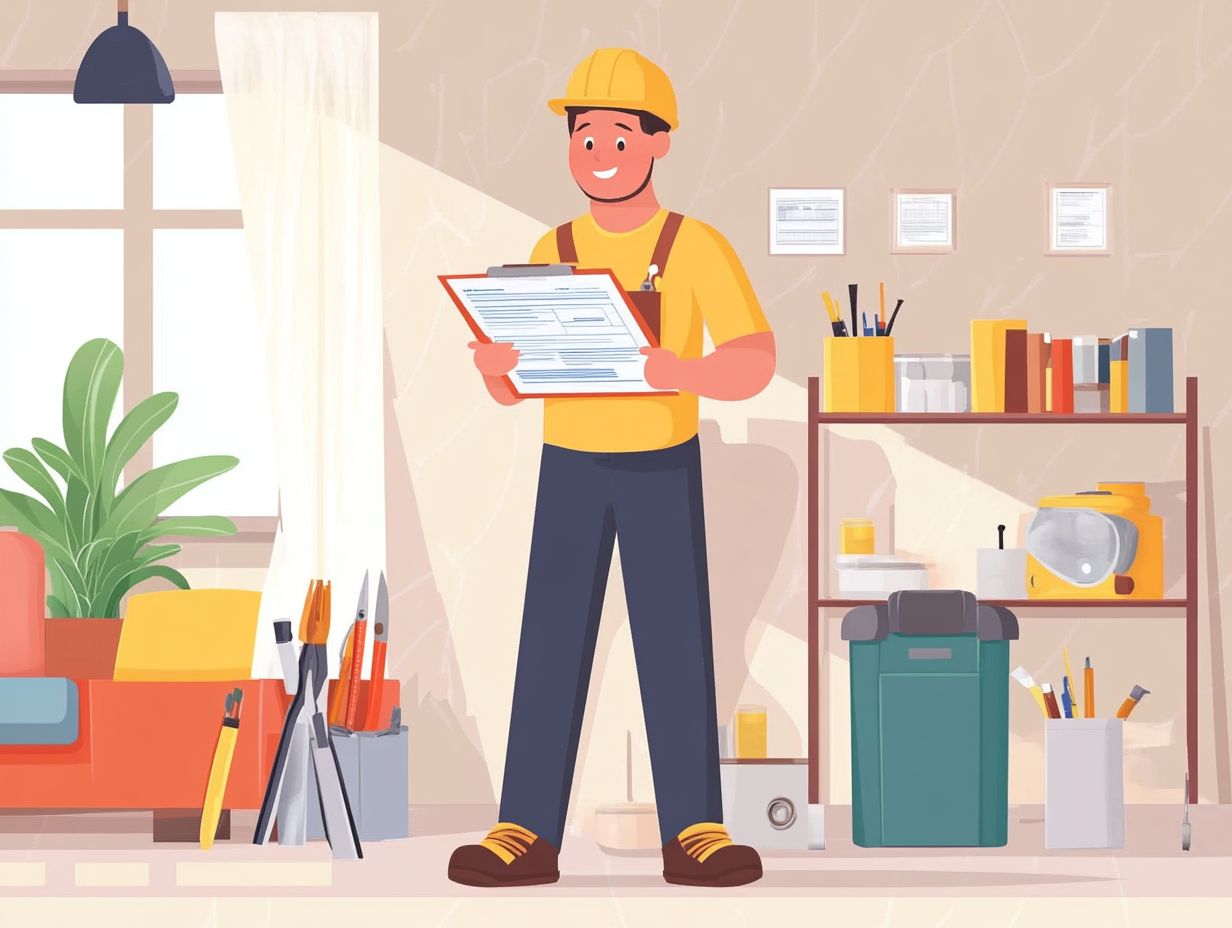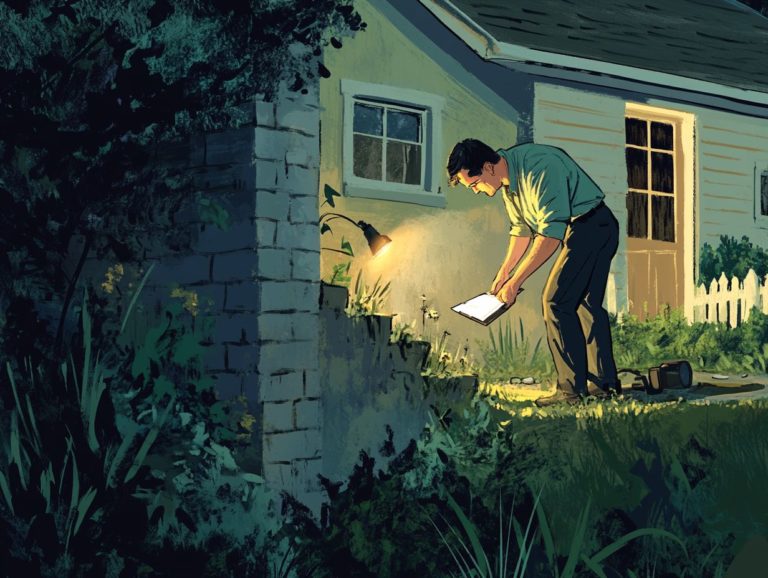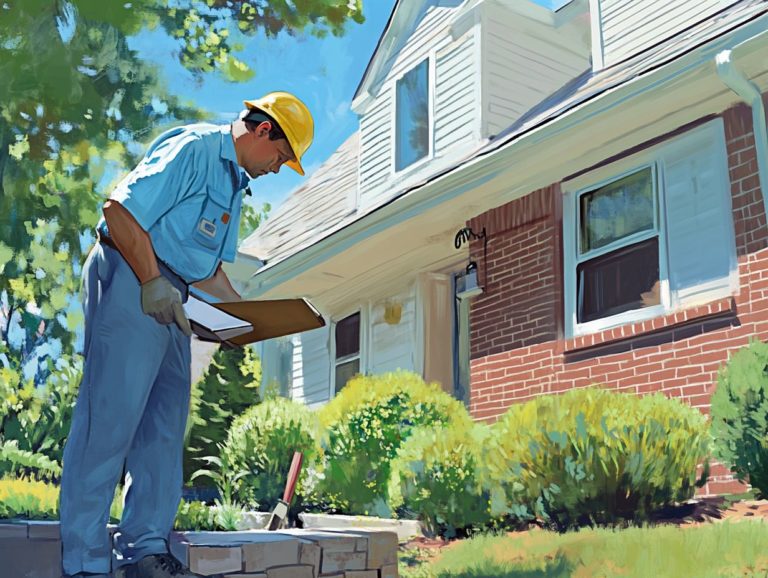What to Expect in a Home Inspection Report
Buying a home is one of the most significant investments you ll ever make, and understanding its condition is essential.
A home inspection report acts as your roadmap, uncovering potential issues and guiding your decisions along the way. Discover why a home inspection is crucial for your peace of mind and financial security!
This article delves into the importance of obtaining a home inspection, outlines what the report encompasses, highlights common red flags, and offers tips for interpreting the findings effectively.
It also explains how to address concerns with sellers after you get your report. Dive in to ensure your home buying journey is as informed and seamless as possible!
Contents
Key Takeaways:

A home inspection report is crucial for understanding the condition of a property and identifying what to look for in a home inspection report to address potential issues that may affect its value and safety.
A thorough home inspection report covers all major areas and systems of a property, including structural, electrical, plumbing, and more.
It is important to carefully review and understand the terminology and recommendations in a home inspection report to address any issues and negotiate with sellers effectively.
Importance of a Home Inspection Report
The significance of a home inspection report is very important, especially in the realm of home buying, where both buyers and sellers rely on this essential document to gauge the property’s condition and pinpoint serious issues.
A thorough home inspection report serves as an invaluable resource for you as a buyer, equipping you to make well-informed decisions about your investment.
It also provides sellers with critical insights into necessary repairs that can elevate their home’s value and attract potential buyers.
Why You Should Get One

Getting a home inspection is crucial for both buyers and sellers, as it unveils serious issues that may not be immediately apparent. This step is essential in the home buying and selling journey.
By utilizing a comprehensive inspection checklist, you can pinpoint critical problems, from structural flaws to outdated electrical systems, saving yourself from potentially costly repairs in the future.
Ignoring these hidden concerns can lead to financial repercussions that significantly impact your budget and negotiations.
For buyers, having a detailed inspection report gives you the power during price discussions, potentially unlocking substantial savings.
Sellers who proactively address any discovered issues can boost their home’s market value and draw in more interested buyers.
Investing in a home warranty grants you peace of mind, covering unexpected repairs and providing an extra layer of protection for all parties involved.
What a Home Inspection Report Covers
A comprehensive home inspection report encompasses a range of vital elements that are essential for understanding the overall condition of the property. This includes an assessment of structural components, the Heating, Ventilation, and Air Conditioning (HVAC) system, plumbing concerns, electrical systems, and various safety issues that could present risks to prospective buyers. Knowing what to expect with a home inspection can help buyers make informed decisions.
Understanding these aspects is crucial for making informed decisions.
Areas and Systems Assessed

During a home inspection, expect a comprehensive assessment of various areas and systems, including the foundation, HVAC system, plumbing, electrical systems, and both the interior and exterior of the building. This thorough examination is designed to uncover any potential issues that could affect your investment.
Each component is meticulously evaluated to ensure safety and functionality. The foundation will be inspected for cracks or signs of settling, which could raise structural concerns.
Your HVAC system will be assessed for efficiency, looking out for issues like improper airflow or outdated units.
In terms of plumbing, the inspector will check for leaks, water pressure, and the condition of pipes, helping you avoid any costly repairs down the line.
Electrical systems will be scrutinized for outdated wiring, faulty circuits, and safety hazards.
Inside the home, spaces will be evaluated for moisture, mold, or pest infestations, while the exterior inspection might reveal issues like roof damage or inadequate drainage. This thorough process ensures that every aspect of the property is considered, giving you peace of mind about your investment.
Ready to start your home buying journey? Get a home inspection today!
Common Issues Found in a Home Inspection
Common issues identified in a home inspection can vary from minor deficiencies to significant problems that may jeopardize both the safety and integrity of the property.
It s vital for you to be acutely aware of these potential defects as you navigate your home buying journey.
Potential Red Flags

Identifying potential red flags during a home inspection is crucial for homebuyers. Serious problems like mold and water damage can lead to long-lasting repercussions if left unaddressed.
Concerns can range from faulty electrical systems to structural issues, each presenting risks to the property’s value and the safety of its occupants.
Ignoring these warning signs can result in costly repairs and ongoing maintenance headaches that could strain new homeowners financially.
A thorough inspection is your best ally in uncovering deeper issues that may not be immediately visible. By understanding the implications of overlooking these red flags, you empower yourself to make better decisions, ultimately protecting your finances and well-being.
Interpreting a Home Inspection Report
Interpreting a home inspection report can pose a challenge. However, grasping its terminology and recommendations is essential for effectively navigating the negotiation process.
This understanding gives you the power to make informed decisions regarding the property. It ensures you re well-equipped to advocate for your interests.
Understanding Terminology and Recommendations
Understanding the terminology and recommendations in a home inspection report is crucial for both buyers and sellers. It equips you to navigate the negotiation strategy with confidence.
The nuances of these reports can significantly influence discussions between both parties in the transaction.
For example, terms like “electrical issues” or “roof repair estimates” can carry varying implications, shifting your perception of the property’s value.
If you encounter recommendations for substantial repairs, you might use this information to negotiate a lower price or request that the seller resolve these issues before closing.
Sellers who understand the inspection results can better defend their asking price and suggest compromises that satisfy both sides. This paves the way for a smoother transaction process.
What to Do After Receiving a Home Inspection Report
Once you receive a home inspection report, it s essential to understand how to tackle any issues that arise.
You should also be prepared to navigate the negotiation process, which might involve requesting additional inspections or addressing follow-up costs.
Addressing Issues and Negotiating with Sellers
Addressing the issues highlighted in a home inspection report and negotiating with sellers requires a carefully crafted strategy. This should take into account both the gravity of the problems and the sellers’ expectations.
This process isn’t just about outlining the necessary repairs; it’s equally important to frame your requests in a way that resonates with the seller’s perspective.
Prioritizing which issues are most critical allows for balanced negotiations, paving the way for win-win outcomes.
Sellers often have emotional ties to their property, so approaching these discussions with empathy can lead to more productive interactions.
They might view repair requests as financial burdens. Suggesting alternatives like requesting credits instead of direct repairs can be a savvy approach to satisfy both parties while preserving the integrity of the deal.






